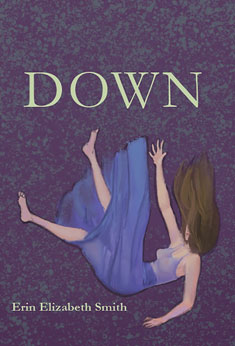Erin Elizabeth Smith’s Down is a wonderful collection of poems that features Alice from Lewis Carroll’s best-selling Alice in Wonderland in an adult setting. The tone of the poems would best be described as world weary, judging by the real-world struggles of the main character, as well as the incorporation of proper name, times, and locations sprinkled throughout the collection.
Down immediately hints at a very unsubtle Alice in Wonderland aesthetic before cracking the spine of the book. On the cover is a picture of a young girl falling, and the epigraph quotes from Alice in Wonderland: “Down, down, down. Would the fall never come to an end?” This would normally be too strong of an homage for the beginning of a book, but where Smith’s collection successfully incorporates Lewis Carroll’s character throughout the entirety of the work, the heavy-handed symbolism works.
Smith keeps up with her homage with the poem “The Carroll Illustrations.” This poem directly names Lewis Carroll and Alice, as well as describes the two characters. The focus of this poem captures the heart of Smith’s Down; she paints the picture of the two characters through the eyes of adult heartache instead of the rose-colored glasses worldview from the original children’s story. This central tone can be found through the entirety of the book. Our beloved childhood character has left Wonderland and is now a struggling woman in America whose husband has left her. By weaving our childhood heroine into an all too realistic, unhappy narrative, Smith brings about a unique perspective to the ideas of change, introspection, uninvited past pain and the experiences of moving forward through adversity. In the poem “The Deer,” Smith likens the tale of her character’s childhood poverty and abuse to the actions of a deer in the woods. In the piece “Alice Gives Advice to Dorothy,” Smith constructs a message of warning from a scorned Alice about the dangers of trusting people. Each of these decisions crafts layer upon layer for our main character, which further invests the reader in her character development through the collection. In many of these poems, Smith creates the atmosphere that both she and the readers are one with the character Alice via first person pronouns. Her poem “Alice Ponders Knoxville” does not name Alice at all, but it uses the word “I” to capture the musings of the character’s thoughts about East Tennessee.
Another thing that makes Down successful is its use of specific locations. The poem “On Waking from the Dream and Finding Nothing” is one of many examples where Smith incorporates proper nouns such as “Kentucky,” “November” and “Knoxville” into her work. These further enhance the adult tone of the narrative. By mentioning these locations and time of year, we as readers are better able to relate to Alice as she journeys the adult world of trials and tribulations. These subtle uses of time and location assimilate the reader toward a worldbuilding that is more mature, naturally.
I would strongly recommend this collection of poems for readers, specifically a target demographic of adult women or girls who are transitioning from young adults into adulthood. I believe readers will enjoy the journey of strife and maturity that Smith crafts with Carroll’s famous character.




